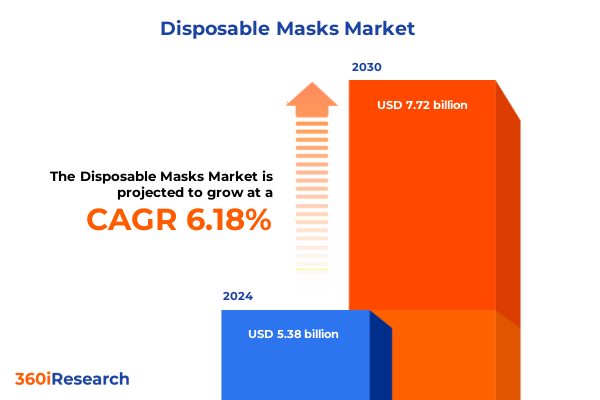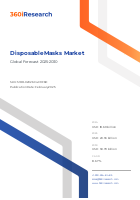The Disposable Masks Market size was estimated at USD 5.38 billion in 2024 and expected to reach USD 5.70 billion in 2025, at a CAGR 6.18% to reach USD 7.72 billion by 2030.

Introduction: The Strategic Importance of Disposable Masks in Today’s Health Landscape
The global emphasis on respiratory protection has never been more pronounced. Disposable masks have evolved from a niche medical supply to a critical component of public health infrastructure, industrial safety protocols, and everyday personal use. In response to recent health crises, governments and private institutions accelerated procurement and adoption, reinforcing the mask as a frontline defense against airborne hazards. Beyond emergency stockpiles, widespread acceptance among consumers has spurred innovations that balance performance with comfort, breathability, and aesthetics. Meanwhile, heightened awareness of supply chain vulnerabilities has prompted companies to reevaluate sourcing strategies and prioritize resilience. This introductory overview sets the stage for a deep dive into the strategic forces reshaping the disposable mask landscape, illustrating how regulatory shifts, material breakthroughs, and market dynamics converge to define the next chapter of this indispensable product category.
Transformative Shifts Redefining the Disposable Mask Landscape
The disposable mask market is undergoing transformative shifts driven by multiple converging trends. First, material science breakthroughs such as electrospun nanofiber filters and antimicrobial coatings are elevating filtration efficiency without compromising wearer comfort. Simultaneously, sustainable alternatives-biodegradable and compostable substrates-are gaining traction in response to stringent environmental regulations and growing consumer demand for eco-friendly products. Digital integration also emerges as a frontier, with smart masks incorporating sensor technologies to monitor air quality and user health metrics. E-commerce expansion continues to redefine distribution models, as online sales platforms leverage personalized marketing and subscription services to reach end-users directly. On the regulatory front, harmonization of global standards and updated certification processes are streamlining approvals while raising the bar for product performance. Collectively, these forces are not only reshaping product portfolios but also triggering strategic partnerships across materials suppliers, technology firms, and logistics providers, setting new benchmarks for quality, sustainability, and market responsiveness.
Cumulative Impact of United States Tariffs in 2025 on Supply Chains and Costs
The introduction of new U.S. tariffs in 2025 marks a pivotal moment for supply chain configuration and competitive positioning. By imposing additional duties on imported nonwoven materials and finished masks, the policy compels manufacturers to reassess their procurement strategies and cost models. As tariffs elevate landed costs for imports, domestic production lines are experiencing renewed investment, with capacity expansions and automation initiatives aimed at mitigating price pressures. Meanwhile, downstream stakeholders-from wholesalers to retail chains-are adjusting sourcing mixes to balance affordability with regulatory compliance. Both established players and emerging brands are exploring nearshoring opportunities in Mexico and Central America to reduce exposure to tariff escalations while preserving turnaround times. In parallel, buyers are negotiating longer-term contracts with domestic suppliers to secure stable pricing, prompting manufacturers to enhance operational efficiency and explore alternative feedstocks. Ultimately, these tariff measures are catalyzing a more regionally diversified production network and stimulating innovation in materials and processes.
Key Segmentation Insights Across Type, Material, Channel, and End-Use
Understanding how different categories shape demand is essential for strategic segmentation. In terms of mask Type, non-surgical masks continue to capture consumer preference for daily wear, while protective respirators-graded as FFP1, FFP2, and FFP3-remain indispensable in industrial and medical environments where defined filtration levels are mandated. Surgical masks, classified into Type I, Type II, and Type IIR, sustain their dominance in hospital settings due to regulatory certification and fluid resistance requirements. Materials play an equally vital role: natural fibers such as cotton appeal to sustainability-focused consumers, non-woven fabrics deliver consistent filtration performance, and polyester blends balance durability with comfort. Distribution channels further delineate market reach; Offline outlets ranging from convenience stores and pharmacies to supermarkets facilitate broad accessibility, whereas Online platforms enable tailored offerings, subscription models, and direct consumer engagement. Finally, end-use segmentation reveals distinct demand patterns: healthcare institutions prioritize certification and bulk procurement, industrial end-users emphasize durability and compliance with occupational safety standards, and personal-use buyers seek masks that combine style, comfort, and protection for everyday activities.
This comprehensive research report categorizes the Disposable Masks market into clearly defined segments, providing a detailed analysis of emerging trends and precise revenue forecasts to support strategic decision-making.
- Type
- Material
- Distribution Channel
- End-Use
Key Regional Insights Shaping Market Priorities and Growth Drivers
Regional attributes and dynamics exert considerable influence over market development. In the Americas, established regulatory frameworks and robust healthcare infrastructure drive sustained demand for high-performance respirators and certified surgical masks, while consumer segments increasingly value eco-certified options. Europe, the Middle East & Africa (EMEA) present a heterogeneous landscape: stringent European Union standards foster innovation in biodegradable and medical-grade products, whereas Middle Eastern markets respond to rapid urbanization with demand for industrial safety masks, and African nations focus on access and affordability. Asia-Pacific stands out as the predominant manufacturing hub, leveraging cost-effective production and integrated supply chains; simultaneous growth in end-use sectors-from healthcare to personal wellness-fuels regional R&D and the adoption of premium mask technologies. These geographic distinctions underscore the need for tailored strategies that address local regulations, infrastructure maturity, and evolving consumer preferences.
This comprehensive research report examines key regions that drive the evolution of the Disposable Masks market, offering deep insights into regional trends, growth factors, and industry developments that are influencing market performance.
- Americas
- Asia-Pacific
- Europe, Middle East & Africa
Key Company Insights Highlighting Competitive Dynamics and Innovation
A cadre of leading corporations and emerging manufacturers are competing on innovation, scale, and strategic partnerships. Industry stalwarts such as 3M Company, Alpha Pro Tech, Ltd., and Ambu A/S are leveraging global footprints and R&D investments to introduce advanced filtration media and smart mask applications. In Asia, Anhui Yongjia Medical Technology Co., Ltd., Besco Medical Limited, Hangzhou Better Medical Device Co., Ltd., Jiangsu Teyin Imp. & Exp. Co., Ltd., Shandong Qunxing Medical Instrument Co., Ltd., and Shanghai Jianpu Medical Equipment Co., Ltd. are capitalizing on high-volume manufacturing capabilities and cost advantages. Leading health-safety conglomerates like Cardinal Health, Inc., Honeywell International Inc., and Drägerwerk AG & Co. KGaA are integrating supply chain efficiencies to meet stringent hospital procurement standards. Regional specialists including ETEX Healthcare Private Limited, KARAM Safety Pvt. Ltd, Kwalitex Healthcare Pvt. Ltd., Magnum Health And Safety Pvt. Ltd., Medi Safe International, and Makrite Industries Co., Ltd. focus on tailored solutions for industrial and personal safety. Global distributors and private-label suppliers such as Kimberly-Clark Corporation, Medicom Group, Medline Industries, Inc., Moldex-Metric Inc., SAS Safety Corporation, and Uvex Group enhance market reach through strategic alliances and channel diversification.
This comprehensive research report delivers an in-depth overview of the principal market players in the Disposable Masks market, evaluating their market share, strategic initiatives, and competitive positioning to illuminate the factors shaping the competitive landscape.
- 3M Company
- Alpha Pro Tech, Ltd.
- Ambu A/S
- Anhui Yongjia Medical Technology Co., Ltd.
- Besco Medical Limited
- Cardinal Health, Inc.
- Drägerwerk AG & Co. KGaA
- ETEX Healthcare Private Limited
- Hangzhou Better Medical Device Co., Ltd.
- Honeywell International Inc.
- Jiangsu Teyin Imp. & Exp. Co., Ltd.
- KARAM Safety Pvt. Ltd
- Kimberly-Clark Corporation
- Koken Medical Co., Ltd.
- Kwalitex Healthcare Pvt. Ltd.
- Magnum Health And Safety Pvt. Ltd.
- Makrite Industries Co., Ltd.
- Medi Safe International
- Medicom Group
- Medline Industries, Inc.
- Moldex-Metric Inc.
- SAS Safety Corporation
- Shandong Qunxing Medical Instrument Co., Ltd.
- Shanghai Jianpu Medical Equipment Co., Ltd.
- Uvex Group
Actionable Recommendations for Industry Leaders to Drive Growth and Resilience
Industry leaders must act decisively to secure competitive advantage in a rapidly evolving environment. First, diversifying supply chains by establishing regional manufacturing nodes or joint ventures can neutralize tariff impacts and enhance responsiveness to local demand fluctuations. Second, investing in sustainable materials development-ranging from compostable non-wovens to recyclable packaging-will differentiate offerings as regulatory bodies tighten environmental compliance. Third, strengthening digital channels, including e-commerce platforms and direct-to-consumer subscription services, will capitalize on growing consumer preference for online acquisition and recurring deliveries. Fourth, forging cross-sector partnerships with technology providers can accelerate the integration of smart sensor capabilities, granting end-users real-time air quality data and usage insights. Finally, dedicating resources to workforce training and automation technologies will optimize production efficiency, reduce labor dependencies, and improve quality control metrics. By implementing these recommendations, market participants can enhance resilience, drive innovation, and reinforce their positions across global markets.
Explore AI-driven insights for the Disposable Masks market with ResearchAI on our online platform, providing deeper, data-backed market analysis.
Ask ResearchAI anything
World's First Innovative Al for Market Research
Conclusion: Positioning for Continued Leadership Amid Evolving Market Dynamics
The disposable mask sector stands at an inflection point where innovation, regulatory shifts, and strategic realignment converge to redefine competitive paradigms. Stakeholders who embrace sustainable practices, diversify production footprints, and leverage digital engagement will capture value as end-user needs evolve. Meanwhile, collaboration across R&D, distribution, and technology domains will unlock new product categories and market segments. As the emphasis on respiratory protection extends beyond episodic health crises to become an integral aspect of personal and occupational safety, the ability to anticipate trends and adapt decisively will distinguish market leaders from followers.
This section provides a structured overview of the report, outlining key chapters and topics covered for easy reference in our Disposable Masks market comprehensive research report.
- Preface
- Research Methodology
- Executive Summary
- Market Overview
- Market Dynamics
- Market Insights
- Cumulative Impact of United States Tariffs 2025
- Disposable Masks Market, by Type
- Disposable Masks Market, by Material
- Disposable Masks Market, by Distribution Channel
- Disposable Masks Market, by End-Use
- Americas Disposable Masks Market
- Asia-Pacific Disposable Masks Market
- Europe, Middle East & Africa Disposable Masks Market
- Competitive Landscape
- ResearchAI
- ResearchStatistics
- ResearchContacts
- ResearchArticles
- Appendix
- List of Figures [Total: 24]
- List of Tables [Total: 325 ]
Call-To-Action: Connect with Ketan Rohom to Access the Comprehensive Disposable Masks Market Report
Discover how your organization can leverage in-depth insights and tailored strategies by reaching out to Ketan Rohom (Associate Director, Sales & Marketing). Engage today to secure the full research report, unlock actionable intelligence on tariffs, segmentation, regional dynamics, and competitive benchmarking, and chart a course for sustained success in the disposable mask market.

- How big is the Disposable Masks Market?
- What is the Disposable Masks Market growth?
- When do I get the report?
- In what format does this report get delivered to me?
- How long has 360iResearch been around?
- What if I have a question about your reports?
- Can I share this report with my team?
- Can I use your research in my presentation?




